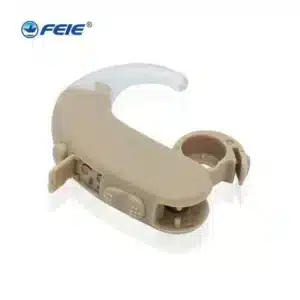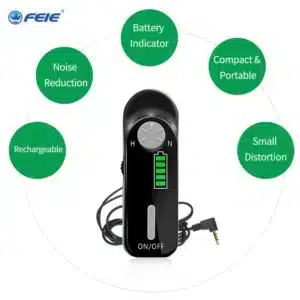“Oticon Medical” is a division of Oticon that focuses on providing hearing solutions beyond traditional hearing aids. Oticon Medical specializes in bone conduction hearing aids and implantable hearing solutions for individuals with various types of hearing loss, especially those who might not benefit from conventional hearing aids. Here’s an overview of what Oticon Medical offers:
1. Bone Conduction Hearing Aids
Oticon Medical offers bone conduction hearing aids, which work by transmitting sound vibrations through the skull bone to the inner ear, bypassing the outer and middle ear. This can be beneficial for individuals with conductive hearing loss, mixed hearing loss, or single-sided deafness.
Models:
Oticon Medical Ponto: A popular line of bone conduction devices that includes different models such as Ponto 4, Ponto 3, and Ponto Plus.
Features: These devices are designed to offer clear sound quality, with features like automatic sound adjustments and the ability to connect to various audio sources.
2. Implantable Hearing Solutions
Oticon Medical also offers implantable hearing solutions for individuals with more complex hearing needs. These solutions are surgically implanted and provide enhanced sound quality and reliability.
Models:
Oticon Medical Ponto System: Includes implantable components like the Ponto Bone Anchored Hearing System, which consists of a small titanium implant placed in the bone behind the ear and a removable sound processor.
Oticon Medical Neuro: A newer system that integrates with advanced neural hearing technology for improved sound processing and personalization.
3. Technology and Benefits
Oticon Medical devices incorporate advanced technology to enhance hearing performance:
Sound Quality: Advanced sound processing algorithms that provide clear and natural sound.
Connectivity: Options for wireless connectivity and streaming from various devices.
Comfort: Designed for long-term wear with attention to comfort and ease of use.
Customization: Tailored to individual hearing loss profiles and preferences.
4. Fitting and Support
Professional Fitting: Oticon Medical devices require fitting and adjustment by an audiologist or hearing care professional. The process often involves a thorough hearing assessment and customization of the device.
Ongoing Support: Regular follow-ups and maintenance are essential to ensure optimal performance and comfort. Oticon Medical provides support through a network of hearing care professionals.
5. Consultation and Access
Consultation: If you’re interested in Oticon Medical products, consult with a hearing care professional or audiologist to determine if these solutions are appropriate for your hearing needs.
Access: You can learn more about Oticon Medical products and find authorized providers through the Oticon Medical website.
In Overall
Oticon Medical provides specialized hearing solutions that address various types of hearing loss, particularly for individuals who may not benefit from traditional hearing aids. Their products include bone conduction hearing aids and implantable systems designed to improve hearing performance and quality of life.

Hearing aid domes, also known as ear domes, are essential components of many hearing aids. They fit into the ear canal and help deliver sound effectively. Here’s a detailed overview of hearing aid domes, including their types, functions, and replacement:
1. Types of Hearing Aid Domes
1. Open Domes:
Description: These domes have small vent holes that allow some natural sound to enter the ear canal. They are designed for people with mild to moderate hearing loss and who do not require significant sound amplification.
Benefits: They provide a more natural sound experience and reduce the sensation of a “plugged” ear.
2. Closed Domes:
Description: Closed domes have no or very small vents, which means they provide a more occlusive fit. They are typically used for people with more severe hearing loss where significant amplification is needed.
Benefits: They offer greater sound amplification and are better at reducing background noise, but they can create a feeling of fullness in the ear.
3. Power Domes:
Description: These are larger and more occlusive than standard closed domes. They are designed for individuals with severe to profound hearing loss.
Benefits: They offer maximum sound amplification and are often used with high-powered hearing aids.
4. Custom-Made Ear Molds:
Description: Custom ear molds are personalized and made specifically to fit the unique shape of your ear canal. They can be made from various materials and are often used for those who need a very secure fit.
Benefits: They provide a custom fit, which can enhance comfort and improve sound quality for those with significant hearing loss.
2. Functions of Hearing Aid Domes
Sound Delivery: Domes help channel sound from the hearing aid into the ear canal, ensuring that the sound amplification is effective and clear.
Comfort and Fit: They help ensure the hearing aid is comfortably secured in the ear canal, preventing discomfort and improving the fit.
Ear Protection: Domes help keep the hearing aid securely in place and protect the internal components from earwax and moisture.
3. Choosing the Right Dome
Hearing Loss Level: Your audiologist will recommend the type of dome based on the severity of your hearing loss and your hearing aid model.
Comfort: Different domes offer varying levels of comfort and fit. It’s essential to choose one that suits your ear shape and comfort preferences.
Sound Quality: The choice of dome can affect the sound quality. Your audiologist can help you select the dome that provides the best sound experience for your needs.
4. Replacing Hearing Aid Domes
1. When to Replace:
Wear and Tear: Domes should be replaced if they become damaged, cracked, or if the fit becomes uncomfortable.
Hygiene: Regular replacement is also important for hygiene reasons. Domes can collect earwax and other debris, which can affect performance and hygiene.
Change in Hearing: If your hearing needs change, you might need to switch to a different type or size of dome.
2. How to Replace:
Purchase New Domes: Replacement domes can be purchased from your hearing aid provider, audiologist, or online hearing aid accessory stores.
Consult Your Audiologist: Your audiologist can provide and fit new domes, ensuring they match your hearing aid model and hearing needs.
Installation: To replace the dome, simply remove the old dome from the hearing aid and push the new dome onto the receiver or speaker until it is securely attached.
5. Cleaning and Maintenance
Regular Cleaning: Clean domes regularly with a soft, dry cloth or brush to remove earwax and debris. Avoid using water or cleaning agents.
Drying: Ensure domes are dry before reattaching them to the hearing aid.
6. Consultation with Hearing Professionals
If you’re unsure about the type of dome you need or how to replace it, consult with your audiologist or hearing care professional. They can provide personalized recommendations and ensure proper fitting and maintenance of your hearing aids.
By understanding the different types of hearing aid domes and their functions, you can ensure that you choose the right one for your needs

The Oticon Minifit receiver is a component used in Oticon hearing aids designed for users who require a discreet and high-performance hearing solution. Here’s an overview of the Oticon Minifit receiver, including its features, compatibility, and care:
1. Overview of Oticon Minifit Receiver
1. Description:
The Minifit receiver is a part of the Oticon hearing aid system that delivers sound from the hearing aid to the ear canal. It is known for its compact size, which makes it a good choice for users who prefer a discreet hearing aid.
2. Purpose:
The receiver (also known as a speaker) amplifies sound and transmits it directly into the ear canal through the hearing aid dome or custom ear mold.
3. Features:
Discreet Design: Designed to be small and inconspicuous while delivering high-quality sound.
High-Performance: Provides clear sound amplification and is compatible with various Oticon hearing aid models.
Comfort: The Minifit receiver is designed to be comfortable for extended wear and to provide a secure fit in the ear canal.
2. Compatibility
1. Hearing Aid Models:
The Oticon Minifit receiver is compatible with certain Oticon hearing aid models that are designed to use the Minifit system. Common models that use Minifit receivers include various versions of the Oticon Opn, Oticon More, and Oticon Xceed hearing aids.
2. Consult Your Audiologist:
To ensure compatibility, consult your audiologist or hearing care professional. They can confirm whether the Minifit receiver is suitable for your specific hearing aid model and hearing needs.
3. Replacing the Minifit Receiver
1. When to Replace:
Performance Issues: If you notice a decrease in sound quality, distortion, or a decrease in amplification, it may be time to replace the receiver.
Physical Damage: If the receiver is cracked, damaged, or showing signs of wear, replacement is necessary.
2. How to Replace:
Purchase a Replacement: Obtain a new Minifit receiver from an authorized Oticon provider or hearing aid retailer.
Installation: The receiver can be replaced by removing the old receiver from the hearing aid and attaching the new one. This typically involves gently pulling out the old receiver and inserting the new one into the same slot. If you’re unsure about how to do this, consult your audiologist for assistance.
Professional Help: It is recommended to have a hearing care professional handle the replacement to ensure proper installation and function.
4. Care and Maintenance
1. Regular Cleaning:
Clean the Receiver: Wipe the receiver with a soft, dry cloth to remove any earwax or debris. Avoid using water or cleaning agents that could damage the receiver.
Drying: Ensure the receiver is dry before reattaching it to the hearing aid.
2. Protect from Moisture:
Use Drying Kits: Place your hearing aids and receivers in a dehumidifying or drying kit regularly to prevent moisture damage.
3. Regular Check-Ups:
Consult Your Audiologist: Schedule regular check-ups with your audiologist to ensure the receivers and other components of your hearing aids are functioning correctly.
Connecting Oticon hearing aids wirelessly involves using Bluetooth or other wireless technologies to link your hearing aids with various devices, such as smartphones, televisions, or other audio sources. Here’s a guide to help you set up wireless connections with Oticon hearing aids:
**1. iPhone:
**2. Android:
**1. Using a TV Adapter:
**2. Using Bluetooth:
**1. Audio Streamers:
**2. Computers and Tablets:
By following these steps, you can connect your Oticon hearing aids wirelessly to a variety of devices, enhancing your listening experience and convenience.
Adjusting the volume on your Oticon hearing aids can usually be done in a few different ways, depending on the model you have. Here’s a general guide to help you with volume adjustments:
If you need replacement parts for Oticon hearing aids, there are several components you might consider replacing, depending on the issue. Here’s a guide to the most common replacement parts and how to obtain them:
Common Replacement Parts
Batteries:
Disposable Batteries: For models using disposable batteries, replacement batteries come in various sizes (e.g., 312, 13, 675). You can purchase them from hearing aid suppliers, pharmacies, or online retailers.
Rechargeable Batteries: For rechargeable models, the battery is typically built into the device. If the rechargeable battery needs replacement, it usually requires professional servicing or replacement by the manufacturer.
Ear Tips and Domes:
Silicone or Foam Domes: These are the soft tips that fit into the ear canal. They can become worn or dirty and may need to be replaced regularly. Replacement domes are available from hearing aid suppliers and are often sold in different sizes and types.
Custom Ear Molds: For custom molds, consult with your audiologist for replacements. These are custom-made for your ear and may need to be remade periodically.
Filters:
Wax Guards or Filters: These protect the hearing aid’s microphone and receiver from earwax and debris. They should be replaced regularly to ensure clear sound quality. Replacement filters can be purchased from hearing aid suppliers or directly from Oticon.
Microphone Covers:
Protective Covers: These help protect the microphones from dust and moisture. They can become clogged over time and may need replacement. Replacement covers are available from hearing aid accessory suppliers.
Receiver or Speaker Units:
Receivers: For hearing aids with detachable receivers, these may need replacement if they are damaged or not functioning properly. These parts are usually replaced by a professional.
Battery Doors:
Battery Compartments: If the battery door becomes damaged or does not close properly, it might need replacement. This is typically a repair job that might be handled by your hearing care provider.
Cables and Connectors:
Connecting Wires: For hearing aids with detachable components or external devices, cables and connectors may need replacement if they are damaged.
How to Obtain Replacement Parts
Authorized Hearing Aid Providers:
Audiologists and Hearing Clinics: They can order replacement parts for you and perform necessary replacements or repairs.
Hearing Aid Retailers: Many authorized retailers have replacement parts available for purchase and can assist with fitting and installation.
Direct from Oticon:
Oticon Website: Visit the Oticon website for information on ordering replacement parts or finding authorized dealers. The website often provides access to support and replacement parts.
Customer Support: Contact Oticon customer support for guidance on obtaining specific replacement parts and any associated procedures.
Online Retailers:
Hearing Aid Accessory Suppliers: Websites like Hearing Direct or other hearing aid accessory stores offer replacement parts for various hearing aid models. Ensure you are purchasing from a reputable source.
Insurance and Warranty:
Check Coverage: If your hearing aids are still under warranty or if you have insurance coverage, check if replacement parts or repairs are covered.
Professional Assistance
For most replacement needs, particularly for internal components like receivers or complex repairs, it’s advisable to consult with a hearing care professional. They can ensure proper installation and maintenance, helping to extend the life of your hearing aids and maintain their performance.
Replacing the rechargeable batteries in Oticon hearing aids generally involves a few different considerations. Here’s a breakdown of the costs and options you might encounter:
How to Manage Tinnitus at Home: If tinnitus is mostly noticed in quiet situations, first you should try using a white noise machine to mask the noise. If you don’t have a white noise machine, a fan, soft music or low-volumed static radio will help.




How do you deal with tinnitus? If tinnitus is mostly noticeable in quiet situations, try using a white noise machine to mask the noise from tinnitus. If you don’t have a white noise machine, a fan, soft music or low-volume radio static also may help.